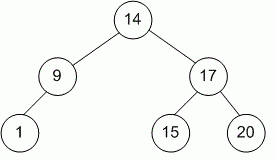Binary trees are a type of Tree data structure wherein each node has at-most 2 child nodes.
We've already discussed about Tree data structure. So, in this article we're gonna talk about the implementation of Binary Trees in C.
 This is how a Binary Tree looks like. As you can see here, no node has more than 2 child nodes.
This is how a Binary Tree looks like. As you can see here, no node has more than 2 child nodes.
Basic structure of Binary Tree
Based on what we've discussed so far, a node of a Binary Tree contains:
- A value
- Left child node
- Right child node
So, based on the above list, we'll make a structure for the same in c. It looks something like this -
typedef struct node{
int data;
struct node *left;
struct node *right;
}NODE;
Here, "left" is a pointer to the Left Child Node and the "right" is a pointer to the Right Child Node.
You can understand this structure by relating it to Linked Lists as well. In linked list we had a pointer called "next", which pointed to the next node of the list, similarly, we have "left" and "right" pointers to point at the left and right child nodes.
Creating a New Node
Now, we're gonna create a new node which will contain the integer value that's gonna be entered by the user. It looks like this -
NODE *createnode(int val){
NODE *newnode = (NODE *)malloc(sizeof(NODE))
newnode->data = val;
newnode->left = NULL;
newnode->right = NULL;
return newnode;
}
So, as you can see: -> First we allocate a new block of memory of "NODE" size to the newnode. -> Then we set the data value of the newnode to the value entered by the user(passed through the argument of the function). -> Then we set both, "right" and "left" equal to "NULL" initially. Later in the program we'll assign values to them.
This is it
I hope you liked reading this post. You can find my other posts here.


